Located at the northernmost tip of Honshu, Aomori Prefecture is renowned as Japan’s leading apple-producing region.
Blessed with rich natural resources and shaped by its harsh climate, it has cultivated a unique culinary culture that reflects both its rugged environment and the warmth of its people.
The diverse landscapes of the Tsugaru Strait, Mutsu Bay, and the Hakkoda Mountains bring seasonal blessings to the local table.
From hearty dishes born to endure the bitter winters to fresh seafood nurtured by fishermen, every flavor is distinctly Aomori.
This time, let’s set out to explore the nostalgic tastes of Aomori.
Senbei-jiru (Nanbu Region)
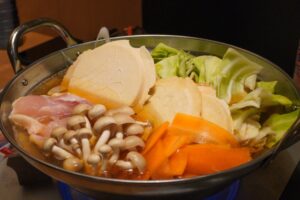
Senbei-jiru, a regional dish from the Nanbu area: Nanbu senbei are broken into a soup and simmered.
A beloved winter dish in the Nanbu region, particularly around Hachinohe, senbei-jiru is a soul-warming family favorite during Tohoku’s harsh winters.
The dish features Nanbu senbei—wheat-based crackers—broken into pieces and simmered in broth with chicken, burdock root, carrots, and mushrooms. This ingenious way of using preserved dried foods is a testament to the wisdom of Aomori’s ancestors.
The senbei soak up the rich flavors, transforming into a delightfully chewy texture.
Simple yet heartwarming, it remains a staple on local tables today.
👉Winner of the Gold Grand Prix (1st Place) at the 2012 B-1 Grand Prix in Kitakyushu.
Keno-jiru (Tsugaru Region)
-300x200.jpg)
Keno-jiru is a traditional winter dish from the Tsugaru region.
A hearty winter dish from the snowy Tsugaru region in northwestern Aomori, keno-jiru is a vegetable-rich miso soup traditionally made without meat.
Finely chopped daikon, burdock root, mountain vegetables, soybeans, and fried tofu are simmered in miso, creating a nourishing stew. The name “keno” comes from a dialectal form of ke (porridge), as the soup was originally eaten in place of rice.
Prepared in advance for the New Year so households wouldn’t need to light fires during the first three days, this mild, wholesome soup reflects the wisdom and warmth of life in snowy Tsugaru.
Ichigo-ni (Hachinohe / Sanriku Coast)
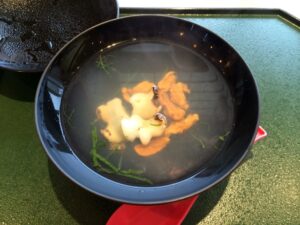
Ichigo-ni is named because the sea urchins floating in the broth resemble wild strawberries.
Along the southeastern coast in Hachinohe, facing the Pacific Ocean, locals have long cherished ichigo-ni—a luxurious clear soup with sea urchin and abalone.
The name, meaning “strawberry stew,” comes from the way the floating sea urchins resemble wild strawberries.
Hachinohe sits at the northern edge of the Sanriku Coast, one of Japan’s richest fishing grounds. Originally a simple fishermen’s meal made right on the shore, ichigo-ni eventually evolved into a celebratory delicacy.
Its delicate balance of briny aroma and natural sweetness embodies the refined yet unpretentious sensibility of Aomori’s coastal people.
Miso Curry Milk Ramen (Aomori City)
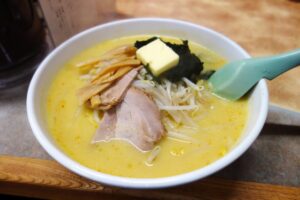
Miso Curry Milk Ramen, a specialty of Aomori City.
A unique local specialty born in Aomori City, this ramen combines miso broth with curry powder and milk—an unusual pairing that surprises with its mellow, rich flavor.
Created in the 1970s by a café for local students seeking something to warm them during Aomori’s frigid winters, it quickly spread by word of mouth.
Today, it’s recognized as a soul food of Aomori, drawing curious visitors eager to try this unexpected but comforting bowl.
Kaiyaki Miso (Tsugaru / Shimokita Regions)
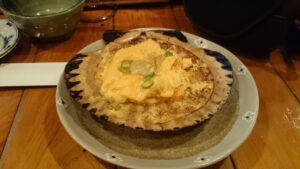
Kaiyaki Miso is made by simmering broth, miso, green onions, and egg in a scallop shell.
A fisherman’s dish from northern coastal areas, kaiyaki miso is prepared by using a large scallop shell as a cooking vessel.
Dashi broth, miso, chopped green onions, and egg are simmered together inside the shell, creating a simple yet flavorful dish.
Once a quick meal for fishermen between catches, it is now served in homes, izakaya pubs, and even at inns for breakfast.
The gentle combination of scallop umami and savory miso leaves a lasting impression of Aomori’s coastal life.
Bara-yaki (Towada City)
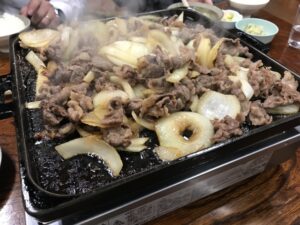
Towada Bara-yaki, featuring plenty of onions and a savory-sweet sauce that whets the appetite.
Towada’s signature dish, bara-yaki, consists of thinly sliced beef ribs and plenty of onions stir-fried in a sweet-savory sauce—perfect with a bowl of rice.
Said to have originated after WWII in Misawa, where it was created for U.S. military personnel using inexpensive beef, the dish eventually became a local favorite in Towada.
Typically cooked right in front of you on a hot iron plate, the sizzling aroma and sweet onions mixed with juicy beef create an irresistible experience.
Awarded the Gold Grand Prix (1st Place) at the 2010 B-1 Grand Prix, bara-yaki now enjoys nationwide fame.
Garlic (Takko Town)
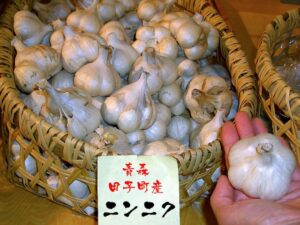
Takko Town in Aomori Prefecture is Japan’s top garlic-producing area.
Takko Town in southwestern Aomori is Japan’s top garlic producer, famous nationwide for its premium Takko garlic.
The region’s drastic temperature swings and mineral-rich soil produce large, fragrant bulbs with a naturally sweet taste.
When roasted, the cloves become creamy and surprisingly mild.
Highly prized by chefs across Japan, Takko garlic is featured in local specialties like whole roasted garlic steaks and rich garlic ajillo.
Every autumn, the “Garlic and Beef Festival” draws crowds eager to enjoy the ultimate pairing of Takko garlic and Takko beef.
Scallops (Mutsu Bay)
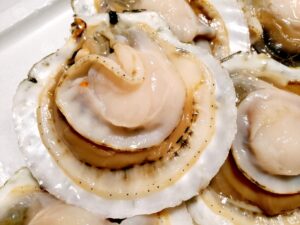
Mutsu Bay in Aomori Prefecture is known as one of Japan’s leading scallop-producing regions.
Mutsu Bay is one of Japan’s leading scallop-producing areas, known for thick, tender meat with a natural sweetness.
The bay’s calm waters and cold currents nurture high-quality scallops prized in markets across Japan and abroad.
While delicious raw or grilled, nothing beats enjoying them fresh on-site—especially hamayaki (grilled scallops cooked right in their shells over charcoal, drizzled with soy sauce).
From buttery grilled scallops to scallop rice, they are a staple of Aomori’s food culture and a familiar sight at family BBQs.
Apple Pie (Throughout Aomori, Especially Hirosaki)
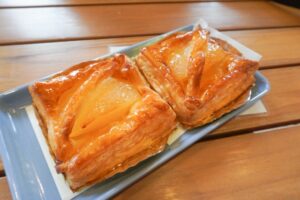
Apple pie is a classic dessert from Aomori Prefecture, Japan’s top apple-producing region.
As Japan’s top apple-growing region, Aomori is also famous for its apple pies.
Hirosaki City, in particular, is known as “the city of apple pies,” with countless cafés and specialty shops offering unique takes on crust texture and apple filling.
Strolling through the castle town near Hirosaki Castle while sampling different pies is a treat in itself.
The flaky crust and sweet-tart apples perfectly embody Aomori’s rich natural bounty.
Kuroishi Tsuyu Yakisoba (Kuroishi City)
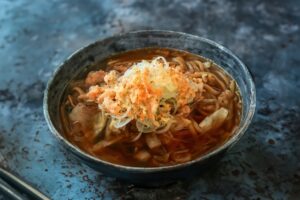
Tsuyu Yakisoba, a unique local specialty of Kuroishi City.
In Kuroishi City, known for its thick, flat noodles in sweet sauce, a quirky evolution of the classic dish emerged: tsuyu yakisoba.
Here, stir-fried noodles are served in hot dashi broth, eaten with chopsticks like soba.
Originating in the 1950s at a local diner, it became a local favorite and a must-try comfort food.
The blend of savory sauce and fragrant bonito-kelp broth creates a nostalgic yet deeply satisfying taste—perfect for warming up on a cold Tsugaru winter day.

Aomori’s food culture is a testament to the wisdom, creativity, and deep respect for nature nurtured by those who have lived in harmony with its harsh yet bountiful environment.
Its dishes are hearty yet gentle, rustic yet warm—each bite reflecting the character of its people. The ever-changing seas and mountains of Aomori create flavors that are truly treasures of this land.
When you visit, take the time to savor each dish, letting the stories and spirit of Aomori unfold with every bite.

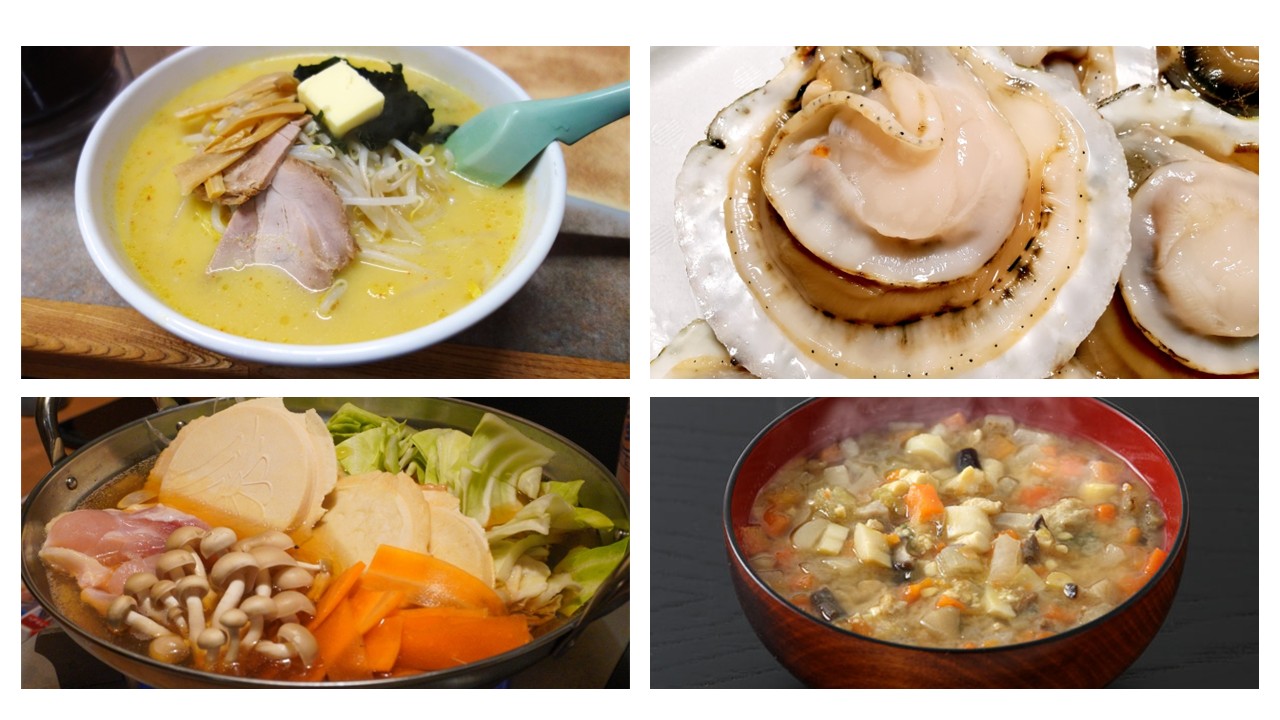


コメント